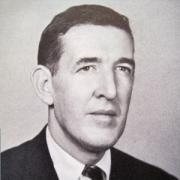William H. Whyte
William H. Whyte | |
|---|---|
 | |
| Born | William Hollingsworth Whyte Jr. July 11, 1917 |
| Died | July 11, 1999(aged 82) New York City, US |
| Resting place | Oaklands Cemetery,West Chester, Pennsylvania, US |
| Education | Princeton University |
| Occupation(s) | Sociologist, urbanist, writer |
| Notable work | The Organization Man,The Social Life of Small Urban Spaces |
William Hollingsworth"Holly"Whyte Jr.(July 11, 1917 – July 11, 1999) was an Americanurbanist,sociologist, organizational analyst,journalistand people-watcher. He identified the elements that create vibrant public spaces within the city and filmed a variety of urban plazas in New York City in the 1970s.[1]After his book about corporate cultureThe Organization Man(1956) sold over two million copies, Whyte turned his attention to the study of human behavior in urban settings. He published several books and a film on the topic, includingThe Social Life of Small Urban Spaces(1980).[2]
Biography
[edit]Whyte was born inWest Chester, Pennsylvaniain 1917. An early graduate ofSt. Andrew's SchoolinMiddletown, Delaware,he graduated fromPrinceton Universityin 1939 and then served inMarine Corpsbetween 1941 and 1944. He was commissioned and served as battalion intelligence officer with the3rd Battalion, 1st Marinesin theGuadalcanal Campaign. He left Guadalcanal at the end of the campaign with a serious case of malaria that lingered for years. He spent the rest of the war lecturing and writing at theMarine Corps Staff and Command Schoolat Quantico, Virginia, on the fighting qualities of the Japanese soldier.[3]
In 1946 he joinedFortune Magazinewhere he remained until 1958.[4]
In 1952, Whyte coined the term "Groupthink":
Groupthink being a coinage – and, admittedly, a loaded one – a working definition is in order. We are not talking about mere instinctive conformity – it is, after all, a perennial failing of mankind. What we are talking about is a rationalized conformity – an open, articulate philosophy which holds that group values are not only expedient but right and good as well.[5]
Whyte wrote a 1956bestsellertitledThe Organization Man[6]afterFortune Magazinesponsored him to do extensive interviews on theCEOsof corporations such asGeneral ElectricandFord.
While working with theNew York City Planning Commissionin 1969, Whyte began to use direct observation to describe behavior in urban settings. With research assistants wielding still cameras, movie cameras, and notebooks, Whyte described the substance of urban public life in an objective and measurable way. These observations developed into the "Street Life Project", an ongoing study of pedestrian behavior and city dynamics, and eventually to Whyte's books such asThe Social Life of Small Urban Spaces(1980) andCity: Rediscovering the Center(1988). "City" presents Whyte's conclusions about jaywalking, 'schmoozing patterns,' the actual use of urbanplazas,appropriate sidewalk width, and other issues. This work remains valuable because it is based on careful observation, and because it contradicts other conventional wisdom, for instance, the idea that pedestrian traffic and auto traffic should be separated.[7][8][9]
Whyte along withProject for Public Spacesworked closely on the renovation ofBryant Parkin New York City.
Whyte served as mentor to many, including the urban-planning writerJane Jacobs,Paco Underhill,who has applied the same technique to measuring and improving retail environments,Dan BiedermanofBryant ParkCorporation, who led the renovation of Bryant Park and theBusiness Improvement Districtmovement in New York City,Fred Kent,who worked with Whyte for a number of years before startingProject for Public Spaces,and futureNew York City Planning Commissioner,heiress and socialiteAmanda Burden.[10]
Whyte married fashion designer Jenny Bell Bechtel in 1964. They had one daughter, Alexandra Whyte.
He is interred at theOaklands Cemeteryin West Chester, Pennsylvania.
Books
[edit]- Is Anybody Listening?(1952)
- The Organization Man(1956)
- The Exploding Metropolis(1958)
- Securing Open Spaces for Urban America(1959)
- Cluster Development(1964)
- The Last Landscape(1968)
- The Social Life of Small Urban Spaces(1980)
- City: Rediscovering the Center(1988)
See also
[edit]References
[edit]- ^Caves, R. W. (2004).Encyclopedia of the City.Routledge. p. 767.ISBN978-0415862875.
- ^"William H. Whyte".Project for Public Spaces.Retrieved16 August2012.
- ^"Patrolling Guadalcanal".16 February 2010.
- ^Kaufman, Michael T. (13 January 1999)."William H. Whyte, 'Organization Man' Author and Urbanologist, Is Dead at 81".The New York Times.Retrieved16 August2012.
- ^Fortune. pp. 114–117, 142, 146. (March 1952)
- ^Hodgson, Godfrey (15 January 1999)."Secret life of US corporations".The Guardian.Retrieved16 August2012.
- ^Silverman, William (1982-01-01)."The Social Life of Small Urban Spaces William H. Whyte, Washington, DC: The Conservation Foundation, 1980. 125 pp. $9.50 (paper) and 16mm color film, 55 minutes, 2 reels, sound. $750.00 (purchase), $75.00 (rental). New York: The Municipal Arts Society, 1980".Urban Life.10(4): 466–468.doi:10.1177/089124168201000411.ISSN0098-3039.S2CID144438419.
- ^Elsheshtawy, Yasser (2015-10-01)."Observing the Public Realm: William Whyte's The Social Life of Small Urban Spaces".Built Environment.41(3): 399–411.doi:10.2148/benv.41.3.399.
- ^Ansley, Robert E. (1980)."Book Review: City: Rediscovering the Center".Carolina Planning Journal.16(1): 80.
- ^Satow, Julie,"Amanda Burden Wants to Remake New York. She Has 19 Months Left.",The New York Times,May 18, 2012. Accessed February 13, 2018.
Further reading
[edit]- Rein, R.K. (2022)American Urbanist: How William H. Whyte's Unconventional Wisdom Reshaped Public Life,Washington DC: Island Press
External links
[edit]- American sociologists
- American architecture writers
- Princeton University alumni
- Urban theorists
- 1917 births
- 1999 deaths
- United States Marine Corps personnel of World War II
- Burials at Oaklands Cemetery
- United States Marines
- 20th-century American non-fiction writers
- 20th-century American male writers
- American male non-fiction writers
- People from West Chester, Pennsylvania
- St. Andrew's School (Delaware) alumni
